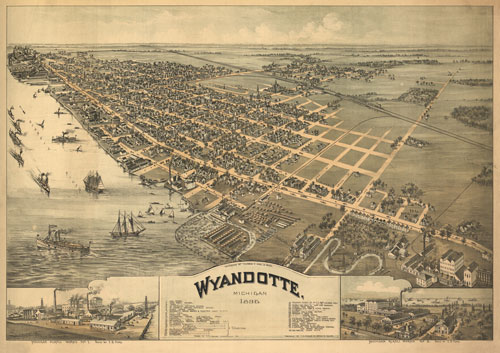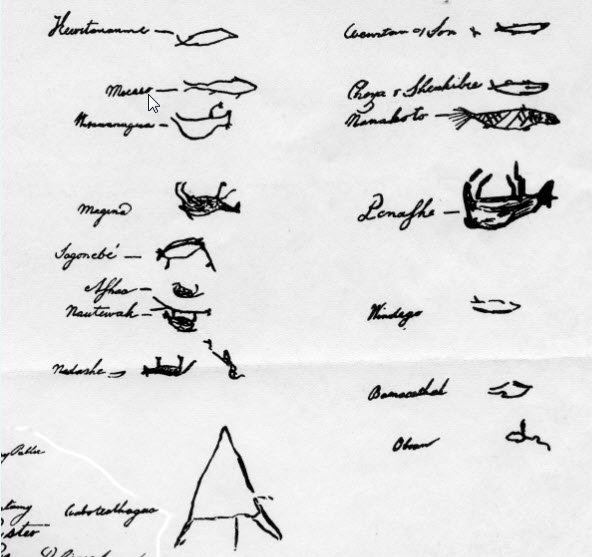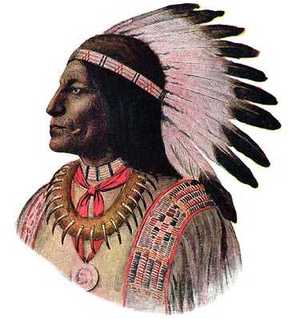Chamber of Commerce excerpt, from publication “Down River Business and Trade Exposition”
It is rather obvious to note that the tone of this documentation was written in an earlier day, where sensitivity to other races and groups were often ignored and, if referred to, were often done so in what now would be classified as unflattering. The following are taken verbatim from their source.

“Jefferson… came with the Indian Era”
“It seems as if all Michigan History has been reticent regarding the removal of the Indians from the vicinity of Detroit River, and the Southern part of the state. Jefferson Avenue was during the Indian era an old trail for hunting grounds and also used by the early settlers in their receiving supplies from the East.
“It is certain that Indians were harshly treated in the early days. Most of the treaties by which they ceded their lands were obtained under duress and it is doubtful if the Indians realized the true purport of them. While they reluctantly ceded their lands to white occupation they generally refused to vacate them until forced to do so.
“The Wyandots who had villages near River Rouge and Ecorse, also Wyandotte and Trenton made a treaty in 1818 by which they were to be permitted to occupy them for fifty years. The treaty of 1807 had provided a reservation of nine sections of land centering about the junction of the River Baisin and Macon. Then with the treaty of 1818 they were compelled to give up this reservation on the Raisin River, and accept a smaller land grant on the Huron River where a park is now located.
“At this location Old Chief Quoque gathered his dwindling band together and built a village. There Chief Quoque died several years later and was buried in the year 1822. Several years ago a fragment of his tombstone was found and was to be set in a concrete monument marking the site of the last Wyandotte village in Michigan.
“The lands in and around River Rouge and south to the Indiana and Ohio (boundary) lines were surveyed and sales began to the public in the year 1818. All over Southern Michigan lands were sold and settlers began to increase every year. The border line of the states just south were not determined in 1818, however the state was called Michigan, which was at that time part of the Northwest Territory. Many disputes were had with the Indians regarding lands and with the state of Ohio regarding ports.
“It was not until the year of 1842 that the Indians of this part of Michigan were rounded up and taken to Sandusky, and then with the (Wyandots) of that place were shipped to Indian Territory. The Potawatomis, another Indian tribe, were rounded up in 1849 by soldiers from Detroit, however some of them escaped and made their way to Canada, where they were domiciled on the lower end of Walpole Island.”
“Ecorse, Michigan”
The main milling area of Great Lakes Steel in Ecorse, c.1906
“Ecorse, Michigan, with the big, beautiful wide super highway of Jefferson Ave., came into its own with the reconstruction of the street in the year 1932. The road was first built after being a trail in much earlier times in 1812 and was first called the Great Military Road. Later it was changed to the River Road and finally with the (extension) of Jefferson Ave. out of Detroit, it was changed to Jefferson Avenue.
“Shortly after 1800 an old publication mentions some nine settlements in Southern Michigan including in them Ecorse. The population of the place originally known as the town of Grandport was small, being composed largely of the original French settlers. The present name is derived from the name of the creek or river now the southern (boundary) which was known in the early days as the River Ecorse.
“The Great Lakes Steel Company began production in Ecorse in August 23, in the year 1930, on the River side, and putting down 72,000 piles to bedrock some seventy feet.
“Frequent additions have been made to the river plant which is one of the greatest in this general area. The Great Lakes Steel pays around $12,000,000 in annual wages, and employs thousands of our inhabitants. Their products are shipped all over the world and are used in every corner of the Earth. Great Lakes Steel Company was indeed a welcome asset to the community and the area is proud of it.”
“Grosse Ile, Michigan”
“Grosse Ile, or known by the Indians as “Kitchieminishen”, was originally inhabited by tribes of the Potawatomie Nation, including the Fox, Sacs, Kickapoos and Potawatomias. The first whites to appear were hunters, traders and trappers who came to the Island to deal with the Indians, and who confirmed their exploration of it, it is believed to the shores.
 The official signatures from Indian natives, shown on the deed awarding Grosse Ile to the Macomb Brothers. Signed July, 1776. The official signatures from Indian natives, shown on the deed awarding Grosse Ile to the Macomb Brothers. Signed July, 1776. | “The first records of any sort regarding the Island were believed made when Father (Louis) Hennepin, with LaSalle, sailed down the strait, between Lake St. Clair and Lake Erie, now the Detroit River, in the “Griffon”, the earliest sailing vessel to appear on the (Great) Lakes.”At this time, trouble with the English and the French which they had between themselves, and who claimed this territory, in which the Iroquois participated, made settlement of Detroit and surrounding country impossible. Finally Antoine De La Mothe Cadillac, in 1696, urged the French government to settle Detroit, and establish necessary fortifications to protect it from the English invasion. He was attracted to Grosse Ile and considered it as the site of the Fort… |
… but was dissuaded when he considered the fact that the timber might not hold out and great difficulty might be encountered in bringing more from the mainland. Too, it was thought that Detroit might be easier to fortify. Thus what is now the intersection of Wayne and Jefferson Avenue in Detroit was the final choice for the Fort (today’s Historic Fort Wayne).
“After assuming command of Detroit for the French, Cadillac parceled out adjoining land to members of his family. He gave to his daughter, Madelaine, in 1707, Grosse Ile and adjacent islands. However, in the year 1711 Cadillac was removed from his post by the French government and all his grants rescinded, and the land once again reverted to the government.
“When the British succeeded the French in control of the island, it was in all intent, still in the hands of the Indians.
“On July 6, 1776, two days after the Declaration of Independence was signed, a certain gentleman who was the fore-runner of the real estate men of today, gained control of great tracts of land and had the signatures of the Indians, in possession of the Island, giving it to them in return for their ‘good will.’ Although the actual deed still seems to be extant, the stories surrounding the transactions have been greatly obscured by legendary.
“The Macomb heirs finally received patents for the grant rights they had made with the Indians in 1811. The heirs in turn then started letting out sections of the territory to tenants.
“Restrictions then started for the development and beautifying of the island and has been going forward to the present day with great success.”
“Trenton, Michigan”
“In 1827, the district was designated the Township of Monguagon by proclamation of Gov. Lewis Cass. The name was that of the name of the Indian chief. On May 25 of the same year, the town was organized and called Truaxton for its founder, Abram Caleb Truax.
“Major Truax, a bounty land surveyor, arrived in 1816 from New York. He had won distinction in the War of 1812. One of the battles in that war took place on the site that was later to become Truaxton. It was the Battle of Monguagon, August 8, 1812. Two cannons, erected as a monument, mark the site of the conflict on the south side of Trenton today.
“Truax required large tracts of land, built the first sawmill, was the motivating force behind the town’s development. His death occurred in the explosion of the Steamer Vance at Windsor docks and he was buried with military honors from the church he had helped to found.
“Following his death, his son, George, continued in his father’s footsteps, taking an active part in the civic and commercial development of the community. (George) operated the first wholesale establishment and carried on the management of the sawmills erected by his father.
“Situated on the government road between Detroit and Toledo, Truaxton was the overnight stop for stage coaches. The town lagged, however, until navigation started on the lakes and river. In 1829, the ‘Superior’, successor to the ‘Walk-In-The-Water’, began regular stops, new docks were built in 1834.
“Meanwhile other settlers had arrived, ship captains began to make Truaxton their home, and the docks presented a busy scene.
“Between 1835 and 1840, most of the residents were engaged in farming and lumbering. Then, because of the strands of fine oak which surrounded the town, shipyards were established and shipbuilding became a large industry. Later the town boasted a second sawmill, stave mills, and factories making plow handles, cheese boxes and cigar boxes. In 1869, the ‘American Champion”, then the largest boat in the Great Lakes, was launched at the town’s shipyards.
“For years the town’s activity centered around the river. Fishing was a profitable business and the livelihood of numbers.
“With the advent of the Lake Shore and Southern railroad in 1852, the town expanded back from the river’s edge. There was a great influx of new residents. In 1860, the Canada Southern railroad entered the territory. Houses began to spring up, roundhouses, foundries, car shops, stations, taverns, stock yards and customs houses came into being. With completion of the line in 1872, Detroit was connected with Buffalo.
“Truaxton was later named Trenton for the straits of limestone which which underlies the district and was quarried as early as 1819. Stone was taken from the quarry and was used in the building the U.S. Arsenal at Dearborn in 1833.
“Located on four major railroads and on the proposed All-American Channel of the Detroit River, Trenton looks forward to future industrial growth. Channel widening and deepening will stimulate navigation anew — and the river which early figured in Trenton’s progress, may again change the map and activities of Trenton.”
“Wyandotte, Michigan”
“The City of Wyandotte was not named after an Indian Chief, as has been so often stated by persons not familiar with the origin of the name, but after a tribe of Indians belonging to the Iroquoian Confederation. When Jacques Cartier made his voyage of discovery up the St. Lawrence River in 1535, he found (Wyandots) then living where now lies the cities of Montreal and Quebec. The French name for the tribe was Huron (from the French word “Hure”).
“They were brave and warlike but were also an agricultural people and were dependent in only a small degree for subsistence upon their skill in hunting. Eventually they were driven from the St. Lawrence Valley by the more numerous Algonquins and then occupied an area adjacent to the western end of Lake Erie to the shores of the Detroit River. At the time Detroit was transferred from the French to British possession, the chief village was on the present site of Sandwich, Ontario. Opposite, on this side of the river, was was a village of the Pottawatomics, and just about to Detroit were located the lodges of Pontiac’s band of Ottawas, whose famous chief had his family home in Peche Ile, in Lake St. Clair.
“During the uprising of the Indian tribes against England, an episode known in history as Pontiac’s Conspiracy, the (Wyandots) were allies of that noted chieftain, and it was during this period that this down-river district attained historical importance.

Chief Pontiac, representing the Ottawa Indian Tribe.
“In 1763 Chief Pontiac gathered on the banks of the Ecorse River, representatives of the various Indian tribes, in council, and through his persuading eloquence, banded them together under his leadership in an attempt to wrest all the frontier posts from British control. He also tried to capture a schooner coming to the relief of the garrison in Detroit, and in this fight, which took place opposite Wyandotte, the Indians were unsuccessful and suffered a loss of 14 dead and many wounded, while the British suffered no serious injuries.
“During the War of 1812, the village of Wyandotte, called by the Indians, Maguagua, and by the French, Monguagon, was located within the present boundaries of Oak St, Biddle and Eureka Aves. and the river, most of this being occupied over half a century later, by the Eureka Iron Co. and the Wyandotte Rolling Mills Co., and after another half century had passed, by the fine residences facing on Van Alstyne Blvd.
“It was the scene of a famous fight during the War of 1812, when Maj. VanHorne, having 200 men in his command, had been dispatched to the River Raisin to act as an auxiliary convoy for the cattle, provisions and mail being brought by Capt. Brush from Chillicothe, Ohio, to Detroit. However, the Indians, in concealment, fired on the brave little band of American Soldiers and their leader fell, and before his comrades could reach the spot, the Indians, allies of the British, bore away his scalplock, an acceptable trophy, to their employers, the British.
“The main column marched on, with rumors of their savages near, but VanHorne, accustomed to alarmists, did not believe them. Suddenly, near the little village of Brownstone, they fell into an ambush and were fired upon by a storm of savage Indians. The attack was quick, sharp, and deadly. VanHorne ordered a retreat and a running fight ensued half way back to the waters of the Ecorses. The attachment left several men killed and several wounded. The scene of this fight is now marked by the emplacement of two cannons just east of the concrete highway, leading south from the village of Trenton.
“Three days later, on August 8, 1812, Lt-Col. Miller was ordered to take 600 men, open the way to the River Raisin, and escort Capt. Brush to Detroit.
Captain Henry Brush. It was his supply caravan from Ohio which had great difficulty arriving at its destination in Michigan, further fanning the flames of the eventual War of 1812. Many of the smaller battles took place in the Downriver area.
“In this scrimmage with the British and the Indians the Americans were successful, and after several days battle and advancing and retreating and trying to reach Detroit by land and boat, they were finally successful.
The scene of this fight from the southerly part of the city of Wyandotte (“north”) to Trenton. At the termination of the War of 1812 and the evacuation of Detroit by the British, the Wyandots ceased to be a factor of this region, and with the exception of possibly occasional individuals, had ceased to reside in this locality.
Many fights and skirmishes were fought with the Indians in the downriver district.”
Trenton Power Plant: A most efficient industry
DTE’s Trenton Channel Power Plant as seen today.
“The principal industry in Trenton is the extraordinary unit of the Detroit Edison Company. It is generally recognized as one of the most efficient electrical power plants of the nation. Therefore electrical power for all industrial uses is unlimited, while rates are so low compared with other great industrial centers as to be worthy of any manufacturers seeking new locations.”